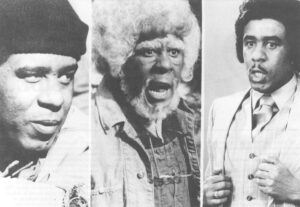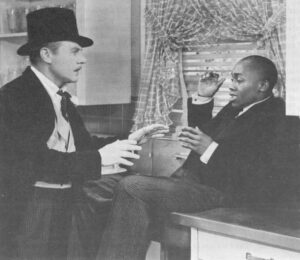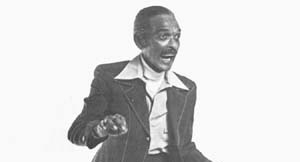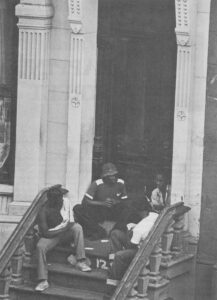Mel Watkins
- 1979

Fellowship Title:
- Black Humor from Stepin Fetchit to Richard Pryor
Fellowship Year:
- 1979

Black Humor: On the Real Side
By ‘jiving’ and ‘schucking,’…a man may avoid the undesirable consequences of his own misdemeanors…’ – Ulf Hannerz, Soulside 1 (NEW YORK) – In this passage Professor Hannerz is describing one of the central elements of black life style analyzed during his sociological study of a relatively contemporary inner-city community. The behavioral pattern described, however, besides its import as a means of survival within black communities and as a buffer against hostility encountered in interactions with whites, is also one of the essential characteristics of traditional black American humor. Moreover, despite its continued evidence in black communities, its roots extend nearly as far back as the initial presence of black slaves in North America. Soon after their arrival in the colonies, after a basic pidgin English had been mastered, black slaves adopted a form of inner-community communication in which the element of obliqueness, double entendre and metaphorical discourse were prominent characteristics. These verbal traits were, of course, initially rudimentary, and in part a carry-over of discourse characteristics common to the West African societies from which most

The Whole Cookie
LOS ANGELES – Fifty years ago Lincoln Theodore Monroe Andrew Perry, a.k.a. Stepin Fetchit, reigned as the first and only black movie star. He had made his motion picture debut in the silent film “In Old Kentucky” (1927) playing opposite Carolynne Snowden; it was a groundbreaking role in which for the first time in a Hollywood film “a clear love affair -a sexual relationship” was depicted between blacks (Slow Fade to Black, Thomas Cripps, Oxford Press, 1977). His real success, however, began in one of the early talkies, “Hearts in Dixie” (1929), where he introduced the dawdling, slow talking, illiterate character that had been created years ago by others on the vaudeville circuit, but would become his trademark. According to his sister, Marie Carter, a hundred or more actors had tried out for the part. “[Step] said he just stood there looking like he didn’t know where he was or why he was there and he was scratching his head, which he had shaved clean, and just looking around like he was lost. I guess

Writing in Black and White
(LOS ANGELES) – “More important than even the directors and producers, the writer is crucial to the success of black television shows,” says Cleavon Little. (Mr. Little, who starred in the Broadway hit “Purlie”, was also a featured performer in the film “Blazing Saddles” as well as television sitcoms such as ABC’s “Temperatures Rising.”) “Usually when stories are bad, black stories on television, it’s because you have white writers who are attempting to write about something they haven’t experienced. Now I’m not against white writers, if a writer’s good he should work. Still, most writers usually write out of their own experience, that’s when they’re best. But not with black shows. Here you have white writers trying to imagine experiences they can’t conceivably know about… If a writer is writing out of his own experience and I, as an actor, am working with the material, I can act, move my body, get into the emotional feel of an authentic situation. “The biggest problem I’ve had in acting is having to say things written for black

That Vaudeville Style: A Conversation with Honi Coles
(NEW YORK CITY) – “When I came to New York in 1931,” recalls Honi Coles, “Harlem was completely different. You can’t visualize it. You can’t possibly visualize it. In the first place, there was little crime, I mean street crime. There was no thought of mugging… none of that existed. Seventh Avenue probably was the prettiest street in all of New York City. It was tree-lined on both sides, from 110th Street to 155th. The island in the middle was wider, and people utilized it – sitting out all hours of the night. Something was always going on. You could go up Seventh Avenue any time of night, especially above 125th Street, between 125th and 145th I’d say, and there must have been a thousand little after-hours spots, you know, and always with some entertainment. “You’d see all these chauffeured limousines out there, chauffeurs sitting up sleeping; they were for, say, people who’d been to Connie’s Inn or the Cotton Club, downtown people. This would be at eight o’clock in the morning; kids would be

Rappin’ on the Street
(NEW YORK CITY) – Booker has been a barber for nearly 40 years. Although he is officially retired now, he still drops into the small barbershop off Northern Boulevard in Queens, where he last worked. If one of the three regular barbers is absent he even puts in a day’s work to help out. But he returns because of the fraternity he finds here, the chance to sit and talk and swap stories with a few of his old customers. In his late 60’s, his speech is hesitant now, and he sometimes struggles to find the right words. When he gets into the telling of a yarn, however, a glint, almost youthful, seems to brighten his face. It’s not difficult to imagine that, as his friends point out, 20 or even 10 years ago he was the best storyteller or “biggest liar” in the area. “It was something back then, son. You youngsters don’t know… we didn’t hardly see no parts a no white folks back then, less they come to collect some money. Missed’um
